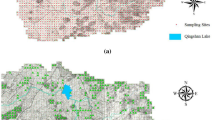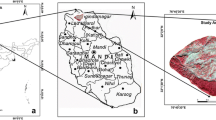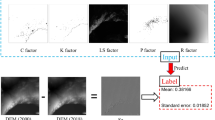Abstract
In this study, the differences in soil properties formed on various periglacial landforms located on slope land and high elevation so, this case create main problem against to soil erosion. The main aims of the study are to determine the physico-chemical properties and some soil erosion sensitivity parameters of the soils formed on the different periglacial landforms of Mount Cin and to predict those soil erosion sensitivity factor using artificial neural network (ANN). It was detected three different periglacial landforms on the Mount Cin. Stony earth circles spread over Cin Hill which is on the summit plain of Mount Cin, while non-sorted steps are located on the northern slopes of Cin Hill and Topkaya Hill. In addition, mud circle landforms spread to the south of Karaçakrak Hill. 25 soil samples were taken from the periglacial landforms in the study area. Afterwards, the physico-chemical properties of the samples were analysed in the laboratory. According to soil analysis from various periglacial landforms, the dominant soil texture is sandy loam: clay ranges from 5.61 to 16.79%, and sand from 48.61 to 76.72%. Also, the average soil erosion sensitivity factors, namely structure stability index (SSI), dispersion rate (DR), and crust formation (CF), were calculated at 29.65, 28.36, and 40.72%, respectively. Moreover, ANN is a model that can operate directly like the human brain. ANN uses the data of the current problem to make predictions. According to regression results of soil erosion sensitivity factors using ANN, the highest prediction rate was obtained for SSI (78%) and the lowest for DR (57%).





Similar content being viewed by others
REFERENCES
P. Alaboz, O. Dengiz, S. Demir, and H. Şenol, “Digital mapping of soil erodibility factors based on decision tree using geostatistical approaches in terrestrial ecosystem,” Catena 207, 105634 (2021). https://doi.org/10.1016/j.catena.2021.105634
R. Amundson, A. A. Berhe, J. W. Hopmans, C. Olson, A. E. Sztein, and D. L. Sparks, “Soil and human security in the 21st century,” Science 348, 6235 (2015). https://doi.org/10.1126/science.1261071
T. Aşkın, F. Türkmen, and C. Tarakçıoğlu, “Evaluation of erosion risk in Ordu province central district soils with geostatistical techniques”, Ordu University, J. Soil Sci. Plant Nutr. 4 (2), 69–75 (2016).
N. Balcı and N. Özyuvacı, “The variation of the erosion tendency in the soils located in two different regions of Turkey depending on the parent material, aspect, land use and sampling depth,” J. Istanbul Univ. Fac. For., Ser. A, 2, 79–107 (1974).
M. Bartz, N. Klasen, A. Zander, D. Brill, G. Rixhon, M. Seeliger, J. Eiwanger, G. C. Weniger, A. Mikdad, and H. Brueckner, “Luminescence dating of ephemeral stream deposits around the Palaeolithic site of Ifrin’Ammar (Morocco),” Quat. Geochronol. 30, 460–465 (2015).
G. R. Blacke and K. H. Hartge, “Bulk density,” in Methods of Soil Analysis, Part 1: Physical and Mineralogical Methods (1986), Vol. 5, pp. 363–375.
G. J. Bouyoucos, “Hydrometer method improved for making particle size analyses of soils,” Agron. J. 54 (5), 464–465 (1962).
C. J. Bronick and R. Lal, “Soil structure and management: a review,” Geoderma 124, 3–22 (2005).
C. Celilov and O. Dengiz, “Determination of spatial distribution of erosion susceptibility parameters with different interpolation methods: Turkey, Ilgaz National Park soils,” Turk. J. Agric. Res. 6 (3), 242–256 (2019).
K. G. Chaudhri, K. W. Brown, and C. B. Holder, “Reduction of crust impedence to simulated seedling emergence by the addition of manure,” Soil Sci. 122, 216–222 (1976).
R. R. Colucci, C. Boccali, M. Zebre, and M. Guglielmin, “Rock glaciers, protalus ramparts and pronival ramparts in the south-eastern Alps,” Geomorphology 269, 112–121 (2016). https://doi.org/10.1016/j.geomorph.2016.06.039
F. Costard, E. Gautier, P. Konstantinov, F. Bouchard, A. Séjourné, L. Dupeyrat, and A. Fedorov, “Thermal regime variability of islands in the Lena River near Yakutsk, eastern Siberia,” Permafrost and Periglacial Processes 33, 18–31 (2022).
O. Çalışkan, G. Gürgen, E. Yılmaz, and S. Yeşilyurt, “Glacial morphology of the northeast of the Bolkar Mountains and debris covered glaciers,” Int. J. Hum. Sci. 9 (1), 890–910 (2012).
V. Dede, O. Dengiz, İ. Demirağ Turan, M. Türkeş, C. Gökçe, and S. Serin, “Determination of relationships between physico-chemical properties of soils formed in periglacial landforms of Ilgaz Mountains and some erosion susceptibility parameters,” Turk. J. Geogr. Sci. 18 (1), 99–123 (2020). https://doi.org/10.33688/aucbd.689755
V. Dede, O. Dengiz, İ. Demirağ Turan, K. Zorlu, S. Pacci, and S. Serin, “Determination of erosion susceptibilities of soils formed on the periglacial landforms of Mount Ilgar and Its estimation using Artificial Neural Network (ANN),” Int. J. Geogr. Geogr. Educ. 47, 258–279 (2022). https://doi.org/10.32003/igge.1097942
M. Demirci and A. Baltacı, “Prediction of suspended sediment in river using fuzzy logic and multilinear r-egression approaches,” Neural Computing and Applications 23 (1), 145–151 (2012).
O. Dengiz, M. A. Özyazıcı, and M. Sağlam, “Multi-criteria assessment and geostatistical approach for determination of rice growing suitability sites in Gökırmak catchment,” Paddy Water Environ. 13 (1), 1–10 (2015).
O. Dengiz and O. Başkan, “Characterization of soil profile developmet on different ladscape in semi-arid region of Turkey a case study; Ankara-Soğulca catchment,” Anatolian J. Agric. Sci. 25 (2), 106–112 (2010).
O. Dengiz and H. Şenol, “Effect of toposequences on geochemical mass balance and clay mineral formation in soils developed on basalt parent material under subhumid climate condition,” Indian J. Geo-Mar. Sci. 47 (9), 1809–1820 (2018).
O. Doğan, M. E. Özel, H. Yıldırım, and N. Küçükçakar, “Erosion risk mapping of Dalaman Basin located in West Mediterranean Region using CORINE method”, in Proceedings of International Symposium on Desertification Konya-Turkey, 2000, pp.125–129.
J. Drewes, S. Moreiras, and O. Korup, “Permafrost activity and atmospheric warming in the Argentinian Andes,” Geomorphology 323, 13–24 (2018).
İ. Dursun and A. A. Babalık, “Determination of vegetation structure of Çatoluk forest pasture in Isparta province,” Turk. J. For. 19 (3), 233–239 (2018).
S. Erinç, T. Bilgin, and M. Bener, “Periglacial landforms on Ilgaz,” J. Istanbul Univ. Inst. Geogr. 12, 90–99 (1961).
M. Fıçıcı and A. Soykan, “Comparative erosion analysis with MPSIAC & RUSLE Methods: Madra Dam Basin,” J. Geomorphological Res. 8, 28–47 (2022).
I. Gaubi, A. Chaabani, A. Ben Mammou, and M. H. Hamza, “A GIS-based soil erosion prediction using the revised universal soil loss equation (RUSLE) (Lebna watershed, Cap Bon, Tunisia),” Nat. Hazards 86 (1), 219–239 (2017).
Y. T. Ghebreiyessus, C. J. Gantzer, E. E. Alberts, and R. W. Lentz, “Soil erosion by concentrated flow: shear stress and bulk density,” Transactions of the ASAE 37 (6), 1791–1797 (1994).
S. Grab, J. Knight, L. Mol, T. Botha, C. Carbutt, and S. Woodborne, “Periglacial landforms in the high Drakensberg, Southern Africa: morphogenetic associations with rock weathering rinds and shrub growth patterns,” Geografiska Annaler: Series A, Physical Geography 103 (3), 199–222 (2021). https://doi.org/10.1080/04353676.2020.1856625
P. Gicheru, C. Gachene, J. Mbuvi, and E. Mare, “Effects of soil management practices and tillage systems on surface soil water conservation and crust formation on a sandy loam in semi-arid Kenya,” Soil Tillage Res. 75 (2), 173–184 (2004).
S. Harriott and D. J. Evans, “Periglacial landforms of Dartmoor: an automated mapping approach to characterizing cold climate geomorphology,” Scott. Geogr. J., 1–28 (2022). https://doi.org/10.1080/14702541.2022.2093394
S. Haykin, Neural Networks: A Comprehensive Foundation, 2nd Ed. (Prentice Hall, Englewood Cliffs, New Jersey, 1999), pp. 117–173.
W. Huang and S. Foo, “Neural network modeling of salinity variation in Apalachicola River,” Water Res. 36 (1), 356–362 (2002).
A. İnce, Master Thesis (Yıldız Technical Univ., Inst. Sci. Technol., 2018).
M. L. Jackson, “Organic matter determination for soils,” in Soil Chemical Analysis (1958).
S. Karaca, O. Dengiz, İ. Demirağ Turan, B. Özkan, M. Dedeoğlu, F. Gülser, S. Demir, B. Sargın, and A. Ay, “An assessment of pasture soil squality based on multi-indicator weighting approaches in 973 semi-arid ecosystem,” Ecol. Indic. 121, 107001 (2021).
E. Kanar and O. Dengiz, “Determination of relationship between land use/land cover and some erodibility indexes in Madendere Watershed Soils,” Turk. J. Agric. Res. 2 (1), 15–27 (2015).
D. Karagöktaş and T. Yakupoğlu, “Relationships between erosiveness and soil properties in an area planned to be transformed into an erosion research area,” J. Soil Sci. Plant Nutr. 2 (1), 6–12 (2014).
M. R. Karaman, A. R. Brohi, N. M. Müftüoğlu, T. Öztaş, and M. Zengin, Sustainable Soil Fertility (Detay Publication, 2007), pp. 15, 29 (2007).
W. D. Kemper and R. C. Rosenau, “Aggregate stability and size distribution,” in Methods of Soil Analysis, Part 1: Physical and Mineralogical Methods, 2nd Ed. (1986). https://doi.org/10.2136/sssabookser5.1.2ed.c17.
İ. Keskin, 1/ 100.000 Scale Geological Maps of Turkey, Ardahan E-49 and F-49 Sheets (MRE General Directorate, Department of Geological Studies, Turkey, 2013), No. 181.
J. Knight, S. Harrison, and D. B. Jones, “Rock glaciers and the geomorphological evolution of deglacierizing mountains,” Geomorphology 324, 14–24 (2019).
T. Kohonen, “Adaptive, associative, and self-organizing functions in neural computing,” Appl. Opt. 26 (23), 4910–4918 (1987).
I. T. Kukkonen, E. Suhonen, E. Ezhova, H. Lappalainen, V. Gennadinik, O. Ponomareva, A. Gravis, V. Miles, M. Kulmala, V. Melnikov, and D. Drozdov, “Observations and modelling of ground temperature evolution in the discontinuous permafrost zone in Nadym, north-west Siberia,” Permafrost and Periglacial Processes 31 (2), 264–280 (2020).
J. Kunz and C. Knesiel, “Three-dimensional investigation of an open-and a closed-system Pingo in northwestern Canada,” Permafrost and Periglacial Processes 32 (4), 541–557 (2021).
R. Kızılkaya, V. Dede, O. Dengiz, and A. Ay, “Effect of soil properties formed on various periglacial landforms in Ilgaz Mountains on dehydrogenase enzyme activity,” Soil Sci. Soc. Turk. 7 (2), 121–127 (2019).
M. Lado, M. Ben Hur, and I. Shainberg, “Soil wetting and texture effects on aggregate stability, seal formation, and erosion,” Soil Sci. 68, 1992–1999 (2004).
R. Lal, Soil Quality and Agricultural Sustainability (CRC Press, 1998).
M. W. Leo, “A rapid method for estimating structural stability of soils,” Soil Sci. 96 (5), 342–346 (1963).
A. Lindgren, G. Hugelius, P. Kuhry, T. R. Christensen, and J. Vandenberghe, “GIS-based maps and area estimates of Northern Hemisphere permafrost extent during the Last Glacial Maximum,” Permafrost and Periglacial Processes 27 (1), 6–36 (2016).
W. Lozinski, “Über die mechanische vermitterung der sandsteine im gemassigten klima,” Bulletin International de I’Academie des Sciences de Cracovie class des Sciences Mathematique et Naturalles 1, 1–25 (1909).
Y. Ma, S. W. Ding, Y. S. Deng, Q. X. Wang, Y. Long, and S. W. Guo, “Study of soil fractal dimension characteristics and spatial variability in collapsing alluvial fan of Wuhuacounty (in Chinese),” J. Soil Water Conserv. 30 (5), 279–285 (2016).
B. Mater, Soil Geography (Çantay Publications, Turkey, 1998).
D. J. Mulla and A. B. McBratney, “Soil spatial variability,” in Handbook of Soil Science, Ed. by M. E. Sumner (CRS Press, Boca Raton, 2000), pp. 321–352.
L. Montanarella, “Agricultural policy: govern our soils,” Nature 528, 32–33 (2015).
M. A. Nearing, Y. Xie, B. Liu, and Y. Ye, “Natural and anthropogenic rates of soil erosion,” Int. Soil Water Conserv. Res. 5 (2), 77–84 (2017).
E. L. N. Ngatunga, I. Lal, and M. J. Singer, “Effect of surface management on runoff and soil erosion from some plot at Milangano, Tanzania,” Geoderma 33, 1–12 (1984).
M. S. Odabaş, G. Kayhan, E. Ergun, and N. Şenyer, “Using artificial neural network and multiple linear regression for predicting the chlorophyll concentration index of Saint John’s Wort Leaves,” Commun. Soil Sci. Plant Anal. 47 (2), 237–245 (2016).
M. Oliva, M. Zebre, M. Guglielmin, P. Hughes, A. Çiner, G. Vieira, X. Bodin, N. Andres, et al, “Permafrost conditions in the Mediterranean region since the Last Glaciation,” Earth-Sci. Rev. 185, 397–436 (2018).
T. Öztekin, B. Cemek, and L. Brown, “Pedotransfer functions for the hydraulic properties of layered soils,” J. Gaziosmanpaşa Univ. Fac. Agric. 24 (2), 77–86 (2007).
K. Öztürk and M. E. Şahin, “An overview of artificial neural networks and artificial intelligence,” Takvim-i Vekayi 6 (2), 25–36 (2018).
S. Pacci, N. S. Kaya, İ. Demirağ Turan, M. S. Odabaş, and O. Dengiz, “Comparative approach for soil quality index based on spatial multi-criteria analysis and artificial neural network,” Arabian J. Geosci. 15 (1), 1–15 (2022).
C. Pieri, Fertilité des terres de savane, Bilan de trenteanné esderecherche et de développement agricole au sud du Sahara (IRAT, Paris, 1989).
D. Pimentel and N. Kounang, “Ecology of soil erosion in ecosystems,” Ecosystems 1 (5), 416–426 (1998).
T. Saraç, “Artificial neural networks,” in Seminar Project (2004), pp. 22–75.
S. Sarıcaoğlu, O. Dengiz, and K. Işık, “Assessment of biogeochemical-mineralogical characteristic and weathering indices of soils developed on basaltic parent material and toposequence under subhumid ecosystem,” Geomicrobiol. J. 38 (5), 451–465 (2021).
F. Saygın, O. Dengiz, S. İç, and A. İmamoğlu, “Evaluation of the relationships between some physico-chemical soil properties and some erodibility parameters at the micro-catchment scale,” J. Artvin Çoruh Univ. Fac. For. 20 (1), 82–91 (2019).
S. Serin, Master Thesis (Bilecik Şeyh Edebali Univ., Institute of Social Sciences, Turkey, 2019).
R. W. Simonson, “Modern concept of soil genesis,” Soil Sci. Soc. Am. J. 23 (2), 152–156 (1959).
Soil Survey Staff, Keys to Soil Taxonomy (United States Department of Agriculture Natural Resources Conservation Service, Washington D.C., 2014).
K. Sönmez, “The effects of phosphoric acid triple superphosphate and barn manure on aggregation, aggregate stability and breaking value in soils of Van region,” Professorship Thesis (Atatürk University Faculty of Agriculture, Turkey, 1982) (in press).
R. Spaccini, J. S. C. M. Bagwu, C. A. Igwe, P. Conte, and A. Piccolo, “Carbohydrates and aggregation in lowland soils of Nigeria as influenced by organic inputs,” Soil Tillage Res. 75, 161–172 (2004).
X. M. Suo, Y. T. Jiang, M. Yang, S. K. Li, K. R. Wang, and C. T. Wang, “Artificial neural network to predict leaf population chlorophyll content from cotton plant images,” Agric. Sci. China 9 (1), 38–45 (2010).
M. Şen, “Engine performance, combustion and emission prediction for canola oil biodiesel blends using Artificial Neural Network,” Düzce Univ. J. Sci. Technol. 7 (3), 2045–2056 (2019).
Z. Şen, Principles of Artificial Neural Networks (Water Foundation Publications, Turkey, 2004).
T. Tunçay, O. Dengiz, and A. İmamoğlu, “Influence of toposequence on physical and mineralogical properties of soils developed on basaltic parent material under sub-humid terrestrial ecosystem,” J. Agric. Sci. 26, 104–116 (2020).
M. Türkeş, V. Dede, O. Dengiz, H. Şenol, and S. Serin, “Periglacial landforms and soil formation on summit of the Mount Ida (Kaz Dağı), Biga Peninsula-Turkey,” Phys. Geogr. (2022). https://doi.org/10.1080/02723646.2022.2091312
T. Uxa, P. Mida, and M. Krizek, “Effect of climate on morphology and development of sorted circles and polygons,” Permafrost and Periglacial Processes 28, 663–674 (2017).
J. R. Wallis and L. Stewan, “Erodibility of some California Midlands soils related to their cations exchange capacity,” J. Geophys. Res. 66 (4), 1225–1230 (1961).
Y. Wang, L. Ran, N. Fang, and Z. Shi, “Aggregate stability and associated organic carbon and nitrogen as affected by soil erosion and vegetation rehabilitation on the Loess Plateau,” Catena 167, 257–265 (2018).
P. J. White, J. W.Crawford, M. C. Díaz Álvarez, and R. García Moreno, “Soil management for sustainable agriculture 2013,” Appl. Environ. Soil Sci. 2014, 536825 (2014).
L. P. Wilding, “Spatial variability: its documentation, accommodation and implication to soil surveys,” in Soil Spatial Variability, Ed. by D. R. Nielsenand and J. Bouma (Pudoc, Wageningen, 1985), pp. 166–194.
S. Zhao, Y. Zhou, M. Wang, X. Xin, and F. Chen, “Thickness, porosity, and permeability prediction: comparative studies and application of the geostatistical modelling in an oilfield,” Environ. Syst. Res. 3 (1), 7 (2014).
Author information
Authors and Affiliations
Corresponding author
Ethics declarations
CONFLICT OF INTEREST STATEMENT
The authors declare that they have no conflict of interest related to the content of this manuscript. The authors have no relevant financial or non-financial interests to disclose.
AUTHORS’ CONTRIBUTIONS
All authors contributed to the study’s conception and design. Methodology, Conceptualization, and Resources were done by V. Dede and O. Dengiz. Supervision was performed by O. Dengiz. Material preparation, investigation, and analysis were performed by İ.D. Turan, S. Serin and S. Pacci. All maps were created by S. Serin, and V. Dede. The first draft of the manuscript was written by V. Dede, O. Dengiz and İ.D. Turan and all authors performed fieldworks and commented on previous versions of the manuscript. All authors read and approved the final manuscript.
ADDITIONAL INFORMATION
The datasets generated and analyzed during the current study are not publicly available but are available from the corresponding author on reasonable request.
Rights and permissions
About this article
Cite this article
Dede, V., Turan, İ.D., Dengiz, O. et al. Effects of Periglacial Landforms on Soil Erosion Sensitivity Factors and Predicted by Artificial Intelligence Approach in Mount Cin, NE Turkey. Eurasian Soil Sc. 55, 1857–1870 (2022). https://doi.org/10.1134/S106422932260138X
Received:
Revised:
Accepted:
Published:
Issue Date:
DOI: https://doi.org/10.1134/S106422932260138X




